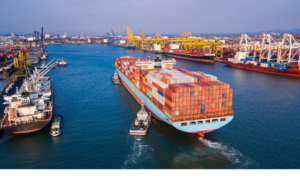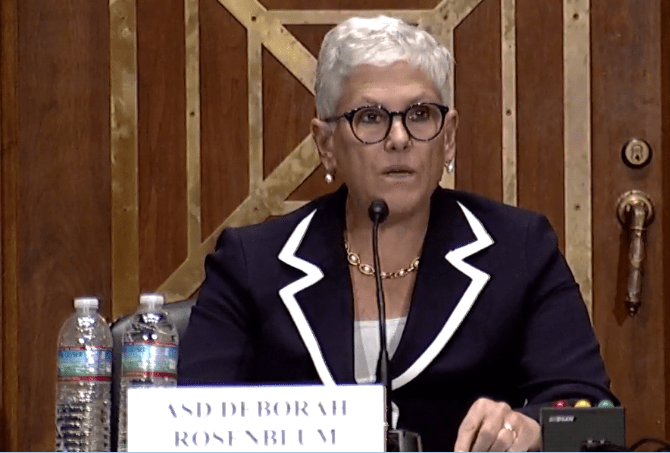She didn’t exactly blame President Biden. But Assistant Secretary of Defense for Industrial Base Policy, Deborah Rosenblum, said the U.S. needed to build domestic supply chains to maintain energy security. This view goes against what the White House did last week in an emergency declaration and presidential proclamation that waived tariffs on Southeast Asian solar exporters, most of whom are in the midst of an anti-dumping investigation by the Commerce Department.
“Revitalizing supply chains requires that the United States make cooperative, strategic, timely decisions to build domestic capacity, collaborate with partners and allies, and safeguard our markets,” she said in her written testimony to the U.S. China Economic and Security Review Commission during a hearing on June 9. “This approach, when balanced across both supply and demand, will facilitate the development of robust markets.”
She also noted that the Defense Department (DoD) is prioritizing China as a long-term challenge, all the while giving China more control over America’s solar market. The two do not blend well.
If solar is to become a major source of electricity in the U.S. by 2035, as Biden has attested numerous times, then as it stands now, the country will be nearly fully reliant on solar imports from Chinese multinationals spread throughout four small Southeast Asian nations and mainland China to keep the lights on, if powered by solar panels.
Even OPEC is a collection of countries. Solar is a collection of Chinese multinationals spread out across five countries, four of which now enjoy near duty free access to the U.S.
Rosenblum said that the Defense Department believes that reliance on sole-source suppliers and a single foreign source “poses risks to domestic capability and capacity to produce the products we require. Over time, many domestic suppliers have lost business and/or exited the market due to unpredictable (government) procurement practices and competitive pressures from foreign nations, particularly China.”
When globalization began in earnest after the fall of the Soviet Union, market forces in the U.S. began prioritizing supply chain efficiency over supply chain resiliency. Events of the last few years (from the pandemic causing sourcing problems to the Ukraine conflict) have made supply chain resilience top of mind in Washington.
However, a lot of that work has gone towards a “work with allies” approach, rather than onshoring critical supply chains, of which solar is one if one deems energy a national and economic security matter.
 Biden’s Supply Chain Review
Biden’s Supply Chain Review
Soon after taking office, President Biden issued Executive Order 14017 to review U.S. supply chains. The EO was aimed at revitalizing, fortifying, and in some instances rebuilding domestic supply chains.
The first directive of the EO called for a 100-day assessment of four critical areas – semiconductors (led by the Department of Commerce), pharmaceuticals (led by the Department of Health and Human Services), high-capacity batteries (led by the Department of Energy), and critical minerals and materials (led by the Department of Defense, which also supported the other three reviews). The responses were consolidated and published on June 8, 2021.
The Department of Defense’s report, which Rosenblum discussed in her written testimony, (see here) focused specifically on addressing challenges in high priority areas critical to operational readiness for the military, including kinetic capabilities; energy storage and batteries; castings and forgings; microelectronics; and strategic and critical materials.
Guess what they found?
“China dominates the global advanced battery supply chain, including lithium hydroxide (94 percent), cells (76 percent), electrolyte (76 percent), lithium carbonate (70 percent), anodes (65 percent), and cathodes (53 percent),” she told the Commission last week.
“China’s lower production costs make importing materials more profitable than producing the same material domestically. It reduces the likelihood of U.S. private capital investment, leading to erosion of the profitability and competitiveness of U.S. manufactured materials and resources.” — Deborah Rosenblum, Assistant Secretary of Defense For Industrial Base Policy, U.S. Department of Defense
China’s ability to offer low prices for goods are a challenge for U.S. manufacturers including the major defense contractors the U.S. relies on to produce its most expensive equipment.
“China’s competitive pricing and aggressive market capture strategy has led DoD’s suppliers to source materials from Chinese producers,” Rosenblum said, as if the U.S. was somehow being arm twisted to buy from the same country the Director of National Intelligence says is the country’s number one strategic threat.
She gave an example: “China has captured more and more of the global steel market, pushing U.S. suppliers out of the market,” she said. “Low-volume and volatile procurement driven by U.S. government and DoD practices compound China’s price advantage by generating high startup costs and limiting profits for U.S. businesses.”
Rosenblum comments stand as a testament to why Biden’s solar decision is bad for national security and energy security.
“Economic security is national security, and our policies reflect that mentality,” Rosenblum said.
But does the White House really agree with that sentiment inside the DoD?
In her oral testimony, Rosenblum said that the growth of China’s manufacturing prowess was not by accident.
“Their leadership recognized the opportunities in a business environment seeking the lowest cost supplier and purposely directed its resources to prioritize initiatives while generating inefficiencies,” she said, perhaps alluding to China’s infamous overcapacity problems, whereas provincial governments are given subsidies from Beijing to produce.
Moreover, the military-civil fusion approach in the Chinese economy today means that benign-looking tech companies — that are statutorily beholden to the CCP in Chinese law — are often in bed with Chinese defense contractors and the People’s Liberation Army and Navy. This is a tricky issue for Washington. While China likes to remind the world it is not the only nation with a military-industrial complex, to compare to U.S. industry, dominated by publicly traded enterprises, is a false comparison. More importantly for the U.S. is the idea that our publicly traded companies that serve the DoD are also still beholden to markets and profits, meaning they still seek foreign adversaries as potential sources of business – i.e. Boeing’s pursuit of China’s passenger jet market. While companies do this dance for now, at some point the time for choosing might find them no longer able to profit off both the U.S. and China.
As it is now, China has seven of the 15 leading defense firms in the world. China is making deliberate efforts to secure supply chain inputs, namely in the metals space, that are necessary to manufacture military goods. Rare earths are an example, Rosenblum said.
Some 18 out of 37 defense-related minerals are either mined in China or processed there. Only 5 are in the U.S., she said in her oral testimony.
Meanwhile, China manufacturing accounts for 25% of the world’s manufacturing output; and within that output, about half can be considered dual use — factories that make widgets for your smartphone and widgets for a surveillance system that’s turned parts of Xinjiang into an open air prison.
“We are addressing a problem 70 years in the making,” Rosenblum told the Committee. “Our current efforts are a down payment on a very large and complex set of challenges. Continuing to build supply chain resilience requires strategy and commitment.”












